|
matriarchy v patriarchy
nature-based v
anti-nature
|
Resources |
Goddess and the Fall books
1/ Jesus Puzzle: Did Christianity Begin with a Mythical Christ? – 1 Jun
2005
by Earl Doherty (Author)
2/ Nailed: Ten Christian Myths That Show Jesus Never Existed at All – 1
Oct
2010
by David Fitzgerald (Author)
3/ The Great Mother: An Analysis of the Archetype (Princeton Classics) –
4
May 2015 by Erich Neumann (Author)
4/ The Woman's Dictionary of Symbols and Sacred Objects – 11 Feb 1988
by Barbara G. Walker (Author)
5/ Women's Encyclopedia of Myths and Secrets – 1 Aug 1996
by Barbara G. Walker (Author)
6/ The Crone – 1 Feb 1991
by Barbara G. Walker (Author)
7/ Man Made God: A Collection of Essays – 15 Apr 2010
by Barbara G. Walker (Author),? D. M. Murdock (Foreword),
8/ The Chalice and the Blade – 1 Oct 1998
by Riane Eisler (Author)
9/ The Serpent and the Goddess: Women, Religion and Power in Celtic
Ireland –
17 Jan 1991 by Mary Condren (Author)
10/ Suns of God: Krishna, Buddha and Christ Unveiled – 1 Sep 2004
by Acharya S (Author)
11/ Christ in Egypt: The Horus-Jesus Connection – 28 Feb 2009
by D. M. Murdock (Author),? Acharya S (Author)
12/ Christ Conspiracy: The Greatest Story Ever Sold – 1 Sep 1999
by Acharya S (Author)
13/ Who Was Jesus? Fingerprints of the Christ – 15 Oct 2007
by D. M. Murdock (Author)
14/ When God Was a Woman (Harvest/HBJ Book) – 4 May 1978
by Merlin Stone (Author)
15/ The Great Cosmic Mother: Rediscovering The Religion Of The Earth – 7
Nov
1991 by Monica Sjoo (Author),? Barbara Mor (Author)
16/ The Language of the Goddess: Unearthing the Hidden Symbols of
Western
Civilization – 26 Feb 2001 by Marija Gimbutas (Author),? Joseph Campbell
(Author)
17/ The Goddesses and Gods of Old Europe: Myths and Cult Images:
6500-3500 BC
Myths and Cult Images – 8 Mar 1982 by Marija Gimbutas (Author)
18/ The Fall: The Insanity of the Ego in Human History and the Dawning
of a
New Era – 13 Oct 2005 by Steve Taylor (Author)
19/ Saharasia: The 4000 BCE Origins of Child Abuse, Sex-Repression,
Warfare
and Social Violence, In the Deserts of the Old World – 20 May 2011
by James DeMeo (Author)
20/ Memories and Visions of Paradise: Exploring the
Universal Myth of a Lost
Golden Age – 1 Apr 1989 by Richard Heinberg (Author)
21/ The Dark Side of Christian History – 1 Jul 1995
by Helen Ellerbe (Author)
Notes and Quotes
20/ Memories and Visions of Paradise: Exploring the Universal Myth of a
Lost
Golden Age – 1 Apr 1989 by Richard Heinberg (Author)
One of particular appeal is a quotation from Ovid written around 8AD
which
laments humanity's loss of its original Golden condition: "..... And the
land, hitherto a common possession like the light of the sun and the
breezes,
the careful surveyor now marked out with long-drawn boundary lines. Not
only
were corn and needful foods demanded of the rich soil, but men bored
into the
bowels of the earth, and the wealth she had hidden and covered with
Stygian
darkness was dug up, an incentive to evil. And now noxious iron and gold
more
noxious still were produced: and these produced war - for wars are
fought
with both - and rattling weapons were hurled by bloodstained hands."
A matriarchal religion is a
religion that focuses on a goddess or goddesses.[1] The term is most
often used to refer to theories of prehistoric matriarchal religions
that were proposed by scholars such as Johann Jakob Bachofen, Jane Ellen
Harrison, and Marija Gimbutas, and later popularized by second-wave
feminism. In the 20th century, a movement to revive these practices
resulted in the Goddess movement.
The concept of a prehistoric matriarchy was introduced in 1861 when
Johann Jakob Bachofen published Mother Right: An Investigation of the
Religious and Juridical Character of Matriarchy in the Ancient World. He
postulated that the historical patriarchates were a comparatively recent
development, having replaced an earlier state of primeval matriarchy,
and postulated a "chthonic-maternal" prehistoric religion.
Additionally, anthropologist Marija Gimbutas introduced the field of
feminist archaeology in the 1970s. Her books The Goddesses and Gods of
Old Europe (1974), The Language of the Goddess (1989), and The
Civilization of the Goddess (1991) became standard works for the theory
that a patriarchic or "androcratic" culture originated in the Bronze
Age, replacing a Neolithic Goddess-centered worldview.[7
Most modern anthropologists reject the idea of a prehistoric matriarchy,
but recognize matrilineal and matrifocal groups throughout human
history.[9]
Criticism
Debate continues on whether ancient matriarchal religion historically
existed.[11] American scholar Camille Paglia has argued that "Not a
shred of evidence supports the existence of matriarchy anywhere in the
world at any time," and further that "The moral ambivalence of the great
mother Goddesses has been conveniently forgotten by those American
feminists who have resurrected them."[12] In her book The Myth of
Matriarchal Prehistory (2000), scholar Cynthia Eller discusses the
origins of the idea of matriarchal prehistory, evidence for and against
its historical accuracy, and whether the idea is good for modern
feminism.[13]
https://en.wikipedia.org/wiki/Matriarchal_religion
The Myth of Matriarchal Prehistory: Why An Invented Past Will Not Give
Women a Future is a book by Cynthia Eller that seeks to deconstruct the
theory of a prehistoric matriarchy. This hypothesis, she says, developed
in 19th century scholarship and was taken up by 1970s second-wave
feminism following Marija Gimbutas. Eller, a professor of religious
studies at Claremont Graduate University, argues in the book that this
theory is mistaken and its continued defence is harmful to the feminist
agenda.
Eller's book has been criticised for mischaracterising the theories of
Gimbutas and other key anthropologists, labeling them as "matriarchalist"
despite most of these scholars rejecting ideas of matriarchy (female
rulership) in favour of matrifocal or matrilineal societies. In her
critique of Eller's book, feminist historian Max Dashu wrote that Eller
"makes no distinction between scholarly studies in a wide range of
fields and expressions of the burgeoning Goddess movement, including
novels, guided tours, market-driven enterprises. All are conflated all
into one monolithic 'myth' devoid of any historical foundation."[2][3]
https://en.wikipedia.org/wiki/The_Myth_of_Matriarchal_Prehistory
Maxine Hammond (born 1950), known professionally as Max Dashu, is an
American feminist historian, author and artist. Her areas of expertise
include female iconography, mother-right cultures and the origins of
patriarchy.
In 1970, Dashu founded the Suppressed Histories Archives to research and
document women's history and to make the full spectrum of women's
history and culture visible and accessible.[1][2] The collection
includes 15,000 slides and 30,000 digital images.[3][4] Since the early
1970s, Dashu has delivered visual presentations on women's history
throughout North America, Europe and Australia.[
Dashu's decades-long work has focused on women's history around the
world, including Europe, Asia and Africa.[3] Areas of focus include
women shamans and priestesses, witches and the witch trials, folk
religion and pagan European traditions. Her work has cited evidence in
support of egalitarian matrilineages, and she authored a critique of
Cynthia Eller's The Myth of Matriarchal Prehistory (2000). Her article
Knocking Down Straw Dolls: A Critique of Cynthia Eller's The Myth of
Matriarchal Prehistory was reprinted in the journal Feminist Theology in
2005.[3][12][13] Dashu has also published in the 2011 anthology
Goddesses in World Culture, edited by Patricia Monaghan.[14]
https://en.wikipedia.org/wiki/Max_Dashu
The Origin of the Family, Private Property and the State begins with an
extensive discussion of Ancient Society which describes the major stages
of human development as commonly understood in Engels' time. It is
argued that the first domestic institution in human history was not the
family but the matrilineal clan. Engels here follows Lewis H. Morgan's
thesis as outlined in his major book, Ancient Society. Morgan was an
American business lawyer who championed the land rights of Native
Americans and became adopted as an honorary member of the Seneca
Iroquois tribe. Traditionally, the Iroquois had lived in communal
longhouses based on matrilineal descent and matrilocal residence, an
arrangement giving women much solidarity and power. Writing shortly
after Marx’s death, Engels stressed the theoretical significance of
Morgan’s highlighting of the matrilineal clan:
The rediscovery of the original mother-right gens as the stage
preliminary to the father-right gens of the civilized peoples has the
same significance for the history of primitive society as Darwin’s
theory of evolution has for biology, and Marx’s theory of surplus value
for political economy.
—?Engels, Friedrich (1884). "Preface to the Fourth Edition". The Origin
of the Family, Private Property and the State. New York: Pathfinder
Press. pp. 27{{subst:ndash;}}38; the quotation is on p.36.
Primitive communism, according to both Morgan and Engels, was based in
the matrilineal clan where women lived with their classificatory sisters
– applying the principle that "my sister’s child is my child". Because
they lived and worked together, women in these communal households felt
strong bonds of solidarity with one another, enabling them when
necessary to take action against uncooperative males.
Engels added political impact to all this, describing the "overthrow of
mother right" as "the world-historic defeat of the female sex"; he
attributed this defeat to the onset of farming and pastoralism. In
reaction, most twentieth-century social anthropologists considered the
theory of matrilineal priority untenable,[7][8] although during the
1970s and 1980s, a range of feminist scholars often attempted to revive
it.[9] The Morgan-Engels argument that early human kinship was
matrilineal is nowadays widely considered to have been
discredited.[citation needed]
"In recent years, evolutionary biologists, geneticists and
palaeoanthropologists have been reassessing the issues, many citing
genetic and other evidence that early human kinship may have been
matrilineal after all.[10][11][12][13] """
(For a critical survey of the current consensus, see Knight 2008, "Early
Human Kinship Was Matrilineal".[14])
https://en.wikipedia.org/wiki/The_Origin_of_the_Family,_Private_Property_and_the_State
Knight 2008, "Early Human Kinship Was Matrilineal".[14])
http://radicalanthropologygroup.org/sites/default/files/pdf/class_text_105.pdf
Monsanto’s Violence in India: The Sacred and The Profane
By Colin Todhunter
Global Research, September 30, 2017
Global Research 24 March 2017
https://www.globalresearch.ca/monsantos-violence-in-india-the-sacred-and-the-profane/5581536
According to Kermani, the Vedic deities have deep symbolism and many
layers of existence. One such association is with ecology. Surya is
associated with the sun, the source of heat and light that nourishes
everyone; Indra is associated with rain, crops, and abundance; and Agni
is the deity of fire and transformation and controls all changes. So
much importance was given to trees, that there was also Vrikshayurveda –
an ancient Sanskrit text on the science of plants and trees. It contains
details about soil conservation, planting, sowing, treatment,
propagating, how to deal with pests and diseases and a lot more.
On the other hand, Kermani notes that the Western religions, especially
Christianity, viewed this nature worship as paganism, failing to
recognise the scientific and spiritual basis of the relationship between
man and nature and how this is the only way to sustain ecological
balance.
****************************************
""""Christians were made to turn all their love and adoration for nature
towards their one and only god, who was a jealous god. The elements of
nature then became devoid of all divinity and were left to be conquered
by man.""""
*********************************************
Articles
The People’s Christmas: Art, Tradition and Climate Change
Sacred Trees, Christmas Trees and New Year Trees: a Vision for the
Future
The Origins of Violence? Slavery, Extractivism and War
Sex, Drugs and Rollickin’ Roles: Christmas and Our Ever-Changing
Relationship with Nature
COME, bring with a noise,
My merry, merry boys,
The Christmas log to the firing ;
While my good dame, she
Bids ye all be free ;
And drink to your heart’s desiring.
With the last year’s brand
Light the new block, and
For good success in his spending
On your psaltries play,
That sweet luck may
Come while the log is a-teending.
Ceremonies for Christmas by
Robert Herrick (1591–1674)
(Psaltries: a kind of guitar, Teending: kindling)
No season has so much association with music as
the mid-winter, Christmas celebrations. The aural pleasure
associated with the tuneful music and carols of Christmas has been
reduced in recent years by the over-playing of same in shopping
malls, banks, airports etc. yet it is still enjoyed and the
popularity of choirs has not diminished.
However, the visual depictions of mid-winter,
Christmas celebration have also been popular since the 19th century
through books, cinema and television.
The depictions of Christmas range from religious
iconography through to the highly commercialised red-suited,
rosy-cheeked, rotund Santa Claus.
Yet, between these two extremes of the sombre sacred
and the commercialised secular lies a popular iconography best
expressed in the realm of fine art and illustration.
Down through the centuries the pagan aspects of
mid-winter celebration and Christmas such as the Christmas tree, the
Yule log, wassailing and carol singing along with winter sports such
as ice skating and skiing have been depicted by many different
artists.
These paintings and illustrations are also
beloved for the visual pleasure they afford.
More importantly, they show aspects of Christmas
which are becoming more important now in our time of climate change.
That is, their depictions of our past respect for nature.
In recent times, as we gradually learned to
harness nature for our own ends through developments in science we
also became less and less worried about the vicissitudes of nature.
Our forebears, however, knew all too well hunger
and cold in the depths of winter and in their own religious and
superstitious ways tried to attenuate the worst of winter hardship
through traditions and practices which would ensure a bountiful
proceeding year.
For example, the Christmas Tree is a descendant
of the sacred tree which was respected as a powerful symbol of
growth, death and rebirth. Evergreen trees took on meanings
associated with symbols of the eternal, immortality or fertility
(See my article on Christmas Trees here).
Evergreen boughs and then eventually whole evergreen trees were
brought into the house to ward off evil influences. Burning the Yule
log was an important rite to help strengthen the weakened sun of
midwinter.
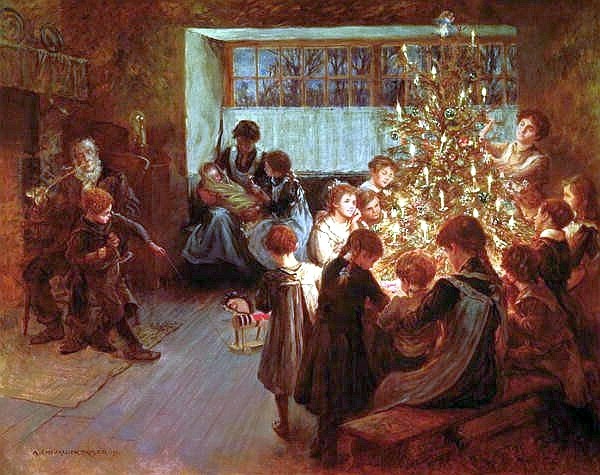
The Christmas Tree (1911)
Albert Chevallier Tayler (1862–1925)
Wassailing, or blessing of the fruit trees, is
also considered a form of tree worship and involves drinking and
singing to the health of the trees in the hope that they will
provide a bountiful harvest in the autumn. Mumming has also been
associated with the spirit of vegetation or the tree-spirit and is
believed to have developed into the practice of caroling even though
mumming is alive and well in many places in Ireland and England.
All these nature-based practices seem to have
been banned by the church at different times and then gradually
integrated into church rituals (presumably because the church was
not able to stop them).
Therefore our relationship with nature was
demonstrated through winter activities both inside and outside the
home. Outside activities consisted of ice skating, caroling,
wassailing, bringing home the Yule log and the Christmas tree.
Inside activities consisted of large gatherings
of family and friends eating, drinking and parlour games. The
indulgence of Christmas activities was balanced by an overriding
concern that nature had been propitiated or appeased.
One aspect the many depictions of these activities
have in common is the festive gathering of large groups of people.
Modern depictions of Christmas tend to emphasise the nuclear family
gathered around the Christmas tree with the focus on what Santa
brought for the children. Thus Christmas today is experienced as a
more isolated experience than in the past.
The decline of the nuclear family in recent
decades with single parent families, divorce, cohabitation, etc has
created extended family gatherings more akin to the past village
groupings. Outdoor activities have also declined though one can
still hear carollers singing on occasion, though still common in
city streets.
Many artists of over the years have tried to depict
the essence of Christmas and midwinter traditions (see my article on
midwinter traditions here)
and thus helped to keep them in our consciences.
Let’s look at some of the illustrations and
paintings that depict mid-winter festivities over the centuries.
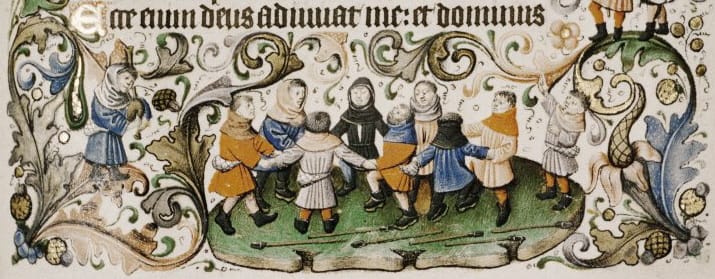
Carole
Carols
Poetry and song are our earliest records of
Christmas celebrations. According to Clement Miles the word “‘carol’
had at first a secular or even pagan significance: in
twelfth-century France it was used to describe the amorous
song-dance which hailed the coming of spring; in Italian it meant a
ring- or song-dance; while by English writers from the thirteenth to
the sixteenth century it was used chiefly of singing joined with
dancing, and had no necessary connection with religion.”[1]
The word carol itself comes from the Old French
word carole, a circle dance accompanied by singers (Latin: choraula).
Carols were very popular as dance songs and processional songs sung
during festivals. In medieval times the
Church referred to caroling as “sinful traffic” and issued decrees
against it in 1209 A.D. and 1435 A.D.
According to Tristram P. Coffin in his Book of Christmas
Folklore, “For seven centuries a formidable series of
denunciations and prohibitions was fired forth by Catholic
authorities, warning Everyman to ‘flee wicked and lecherous songs,
dancings, and leapings’” (p98).
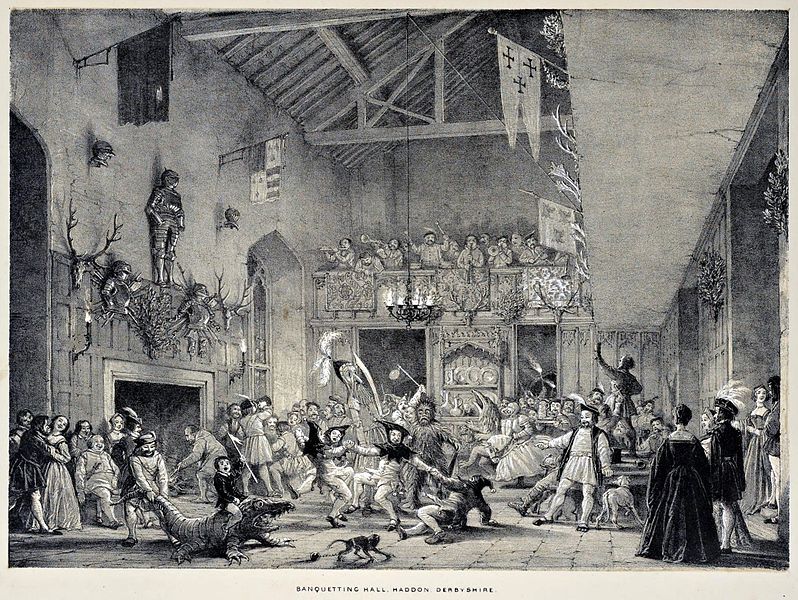
Banqueting Hall
Mumming
The processional
aspects of caroling are linked to mumming, an ancient tradition
which was mentioned in early ecclesiastical condemnations.
During the Kalends
of January a sermon ascribed to St Augustine of Hippo writes that
the heathen reverses the order of things as some of these
‘miserable’ men “are clothed in the hides of cattle; others put on
the heads of beasts, rejoicing and exulting that they have so
transformed themselves into the shapes of animals that they no
longer appear to be men … How vile further, it is that those who
have been born men are clothed in women’s dresses, and by the vilest
change effeminate their manly strength by taking on the forms of
girls, blushing not to clothe their warlike arms in women’s
garments; they have bearded faces, and yet they wish to appear
women.” [2]
The original idea
of wearing the hides of animals, Miles writes, may have sprung “from
the primitive man’s belief ‘that in order to produce the great
phenomena of nature on which his life depended he had only to
imitate them’. [3]
Indeed, in Ireland, mumming is a tradition that
is still going strong.
In a recent article in The Fingal Independent,
Sean McPhilibin notes that
“In North County Dublin the masking would be traditionally made from
straw and would have been big straw hats that cover the face and
come down to the shoulders.” McPhilibin also states that mumming was
“a mid-winter custom that in Ireland and North County Dublin and in
parts of England as well, the masking element is accompanied by a
play. So there’s a play in it with set characters. It’s a play where
the principal action takes place between two protagonists – a hero
and a villain. The hero slays the villain and the villain is revived
by a doctor who has a magical cure and after that happens there’s a
succession of other characters called in, each of whom has a rhyme.
So every character has a rhyme, written in rhyming couplets.[…] The
other thing to say about it is that you find these same type of
characters all across Spain, Portugal, France, Germany, Austria,
Switzerland, over into Slovenia and elsewhere.”
James Frazer, in The Golden Bough, discusses
at length many international examples of people being being
completely covered in straw, branches or leaves as incarnations of
the tree-spirit or the spirit of vegetation, such as Green George,
Jack-in-the-Green, the Little Leaf Man, and the Leaf King.[4]
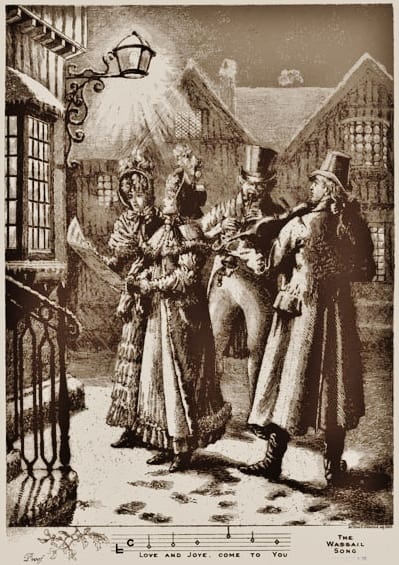
Wassail
Wassail
The word wassail
comes from Old English was hál, related to the Anglo-Saxon
greeting wes þú hál, meaning “be you hale”—i.e., “be
healthful” or “be healthy”.
There are two variations of wassailing: going from
house to house singing and sharing a wassail bowl containing a drink
made from mulled cider made with sugar, cinnamon, ginger and nutmeg,
topped with slices of toast as sops or going from orchard to orchard
blessing the fruit trees, drinking and singing to the health of the
trees in the hope that they will provide a bountiful harvest in the
autumn. They sing, shout, bang pots and pans and fire shotguns to
wake the tree spirits and frighten away evil demons.
The wassail itself
“is a hot, mulled punch often associated with Yuletide, drunk from a
‘wassailing bowl’. The earliest versions were warmed mead into which
roasted crab apples were dropped and burst to create a drink called
‘lambswool’ drunk on Lammas day, still known in Shakespeare’s time.
Later, the drink evolved to become a mulled cider made with sugar,
cinnamon, ginger and nutmeg, topped with slices of toast as sops and
drunk from a large communal bowl.” (See traditional wassail recipe here)
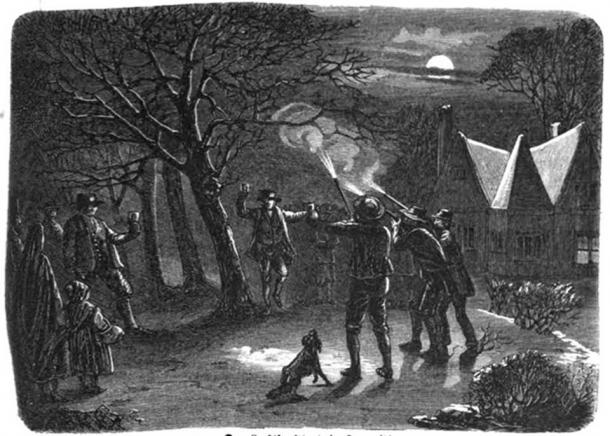
Wassail
The Lord of Misrule
The Lord of
Misrule was a common tradition that existed up to the early
nineteenth century whereby a peasant or sub-deacon appointed to be
in charge of Christmas revelries, thus the normal societal roles
where reversed temporarily. The Lord of Misrule “would
invite traveling actors to perform Mummer’s plays, he would host
elaborate masques, hold large feasts and arrange the procession of
the annual Yule Log.”

Mummers by Robert Seymour, 1836
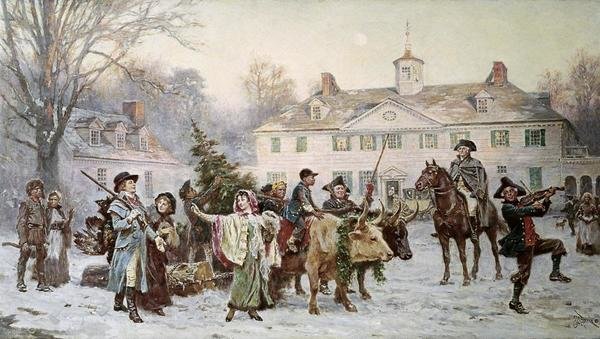
The Mount Vernon Yule Log
Jean Leon Gerome Ferris (1863–1930)
The Bean King
During the the Twelfth Night feast a
cake or pie would be served which had a bean baked inside. The
person who got the slice with the bean would be ‘crowned’ the Bean
King with a paper crown and appointed various court officials. A
mock respect would be shown when the king drank and all the party
would shout “the king drinks”. Robert Herrick mentions this in his poem Twelfth
Night: or, King and Queen:
“NOW, now the mirth comes
With the cake full of plums,
Where bean’s the king of the sport here ;
Beside we must know,
The pea also
Must revel, as queen, in the court here.”

Twelfth-night (The King Drinks)
David Teniers the
Younger (1610–1690)
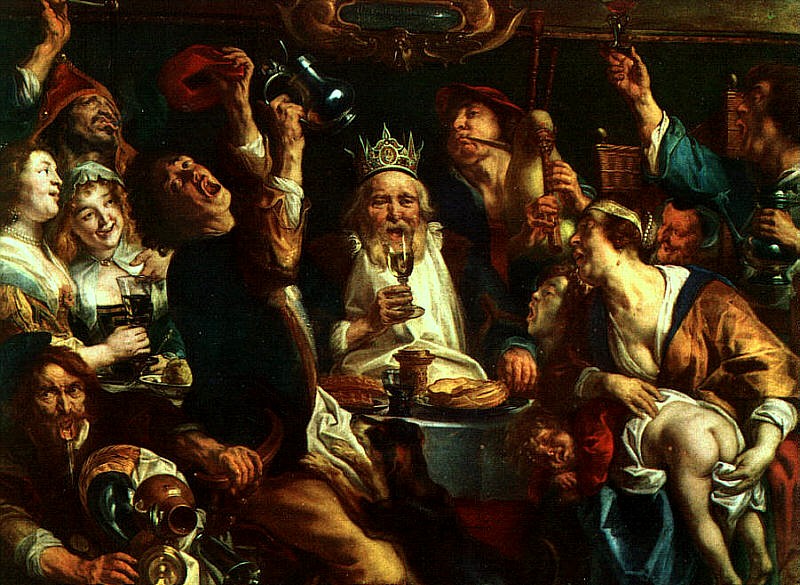
The King Drinks (c.1640)
Jacob (Jacques) Jordaens (1593–1678)
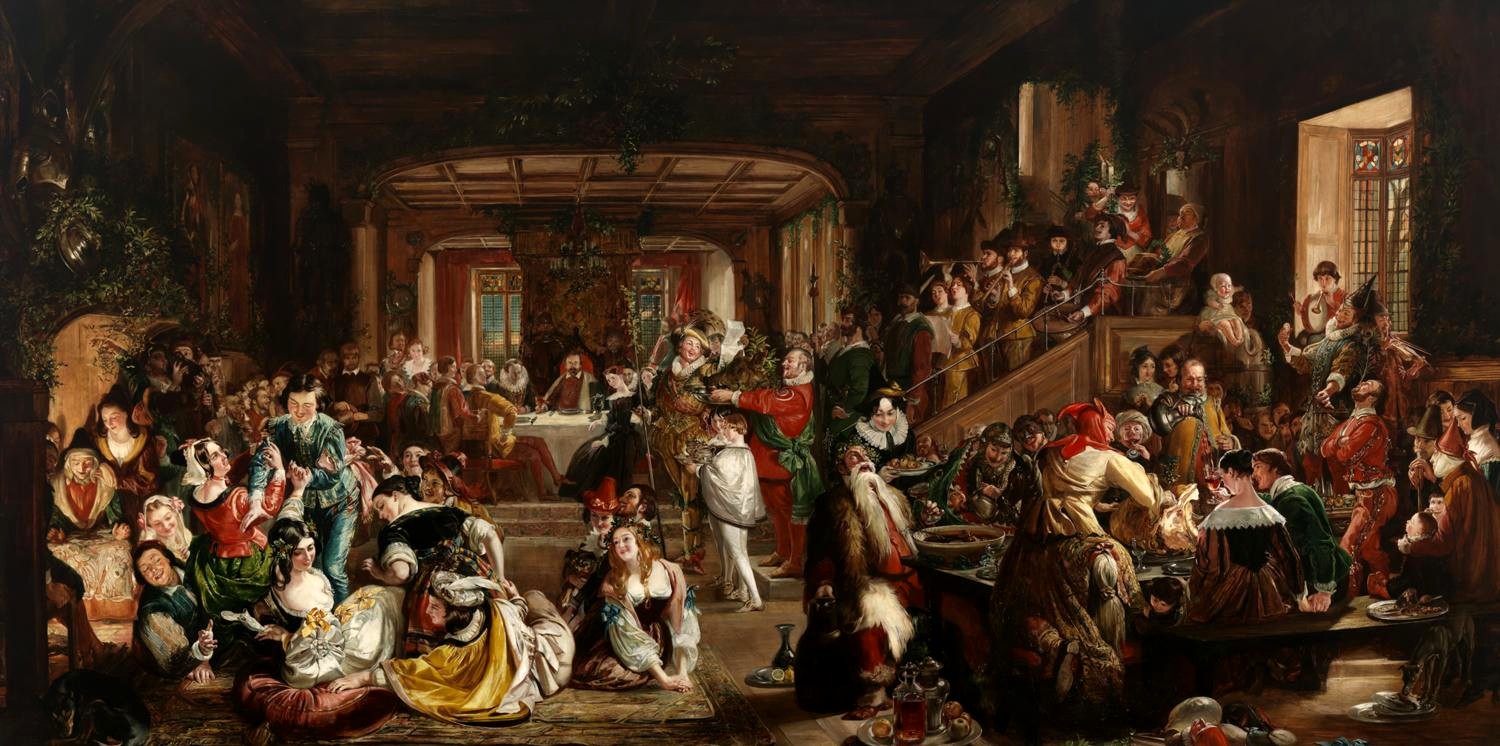
Merry Christmas in the Baron’s Hall (1838)
Daniel Maclise (1806-1870)
Merry Christmas in the Baron’s Hall (1838)
Daniel Maclise’s painting Merry Christmas in the
Baron’s Hall (1838) contains many aspects of the traditional
Christmas festivities. The Lord of Misrule stands in the centre
holding his staff and leading the procession of musicians and
carolers coming down the stairs. Father Christmas, ‘ivy crown’d’,
sits in front of the wassail bowl and is surrounded by mummers (the
Dragon and St George sit side by side) and local people. On the left
side of the picture we see a group of people playing a parlour game
called Hunt the Slipper.
Maclise was influenced by Sir Walter Scott’s poem Marmion:
A Tale of Flodden Field, published in 1808. Marmion is a
historical romance in verse of 16th-century Britain, ending with the
Battle of Flodden in 1513. Marmion has
a section referring to Christmas festivities:
“The wassel round, in good brown bowls,
Garnish’d with ribbons, blithely trowls.
There the huge sirloin reek’d; hard by
Plum-porridge stood, and Christmas pie:
Nor fail’d old Scotland to produce,
At such high tide, her savoury goose.
Then came the merry maskers in,
And carols roar’d with blithesome din;
If unmelodious was the song,
It was a hearty note, and strong.
Who lists may in their mumming see
Traces of ancient mystery;
White shirts supplied the masquerade,
And smutted cheeks the visors made;
But, O! what maskers, richly dight,
Can boast of bosoms half so light!”
(See full text here)
It seems that Maclise was also taken enough by the
poem to pen his own poem about his painting which was published in
Fraser’s Magazine for May in 1838. The poem is titled: Christmas
Revels: An Epic Rhapsody in Twelve Duans and was published under
the pseudonym, Alfred Croquis, Esq. The painting includes over one
hundred figures covering many different traditions of Christmas and
in his poem Maclise describes most of the activities taking place as
some these excerpts from the poem demonstrate:
“Before him, ivied, wand in hand,
Misrule’s mock lordling takes his stand;
[…]
Drummers and pipers next appear,
And carollers in motley gear;
Stewards, butlers, cooks, bring up the rear.
Some sit apart from all the rest,
And these for merry masque are drest;
But now they play another part,
Distinct from any mumming art.
[…]
First, Father Christmas, ivy-crown’d,
With false beard white, and true paunch round,
Rules o’er the mighty wassail-bowl,
And brews a flood to stir the soul:
That bowl’s the source of all their pleasures,
That bowl supplies their lesser measures”
(See full text here)
Winter Landscapes
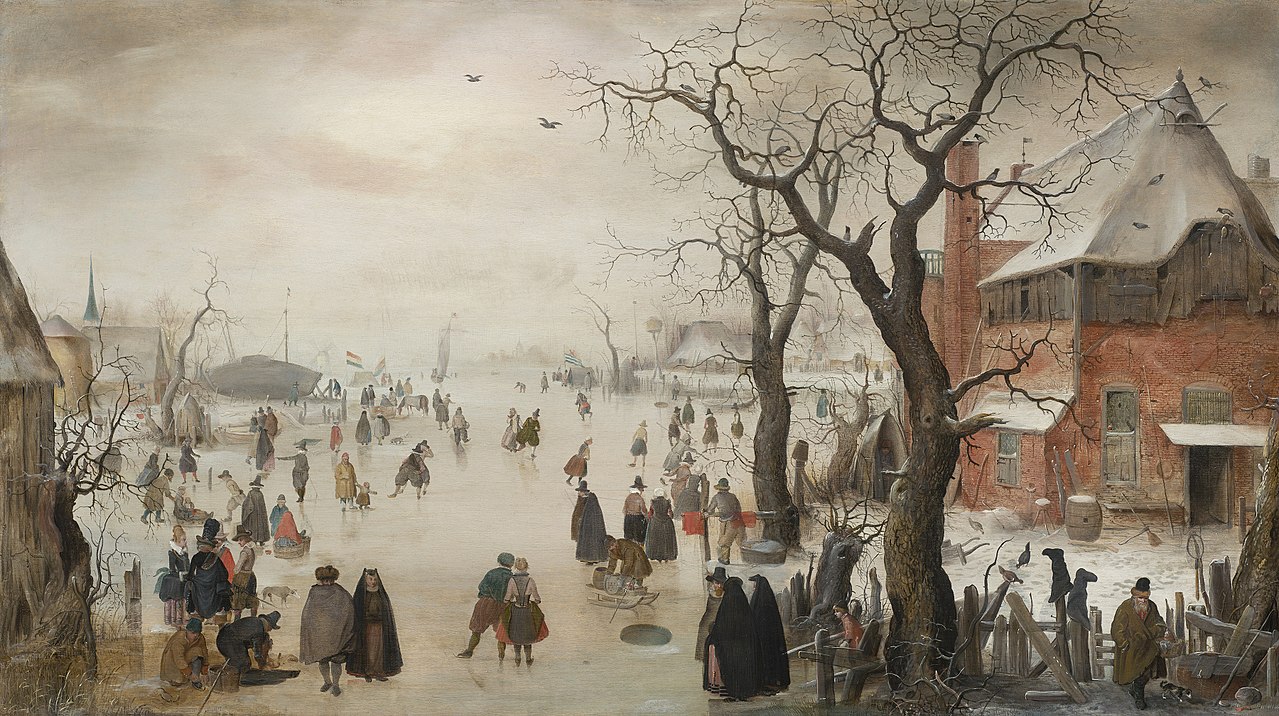
Winter Landscape near a Village
Hendrick Avercamp (1585
(bapt.) – 1634 (buried))

The Hunters in the Snow (1565)
Pieter Bruegel the
Elder (c.1525-1530–1569)
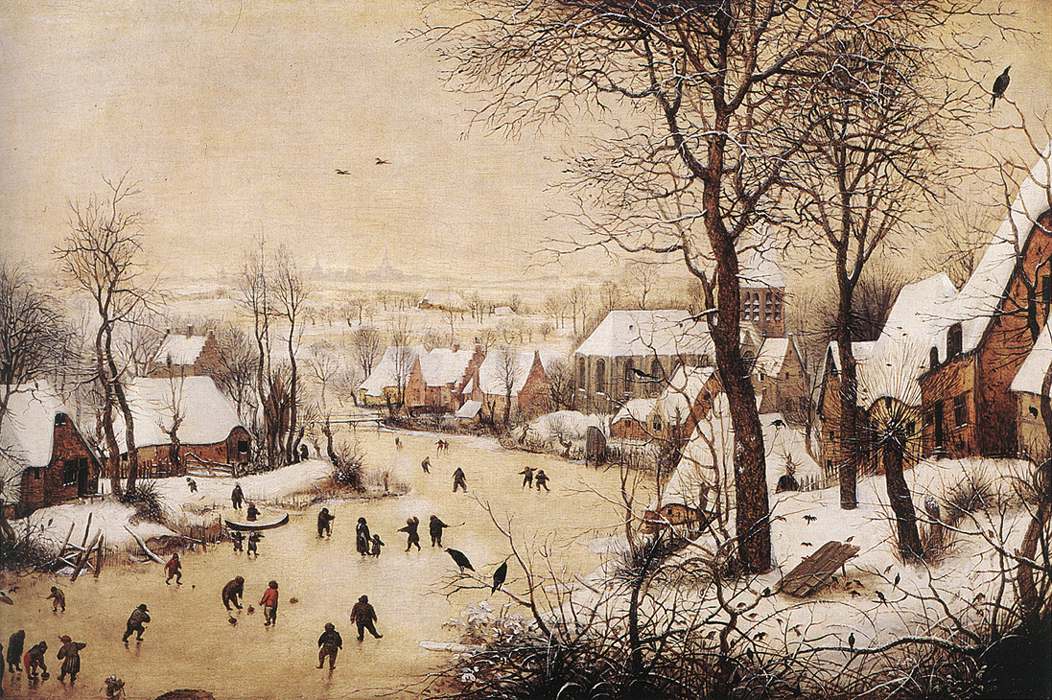
Winter Landscape with Skaters and Bird Trap (1565)
Pieter Bruegel the
Elder (c.1525-1530–1569)
These famous winter landscape paintings by Pieter
Brueghel the Elder, such as The Hunters in the Snow and Winter
Landscape with Skaters and Bird Trap are all thought to have been
painted in 1565. Hendrick Avercamp also made made many snow and ice
landscapes coinciding with the Little Ice Age. Three particularly
cold intervals have been described as
the Little Ice Age: “one beginning about 1650, another about 1770,
and the last in 1850, all separated by intervals of slight warming”.
Outdoor Activities: Skating, Markets and Fairs
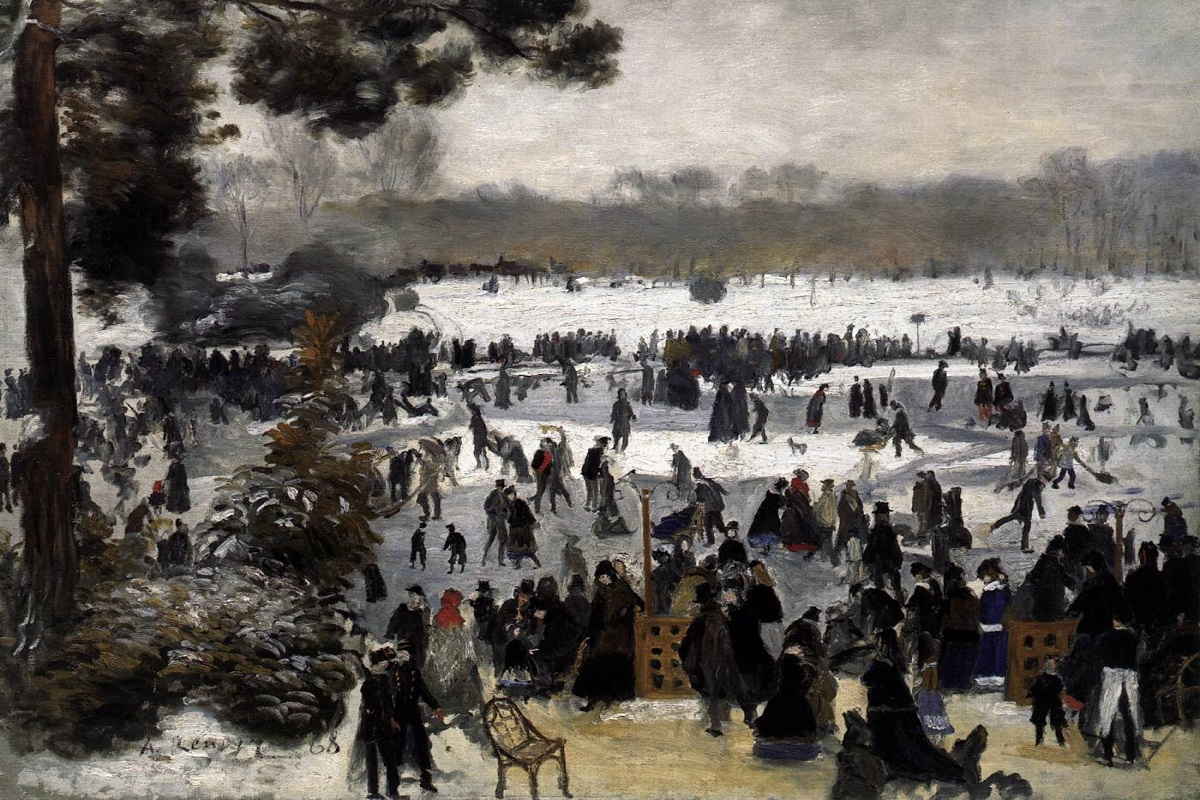
Patineurs au bois de Boulogne (1868)
Pierre-Auguste Renoir (1841–1919)
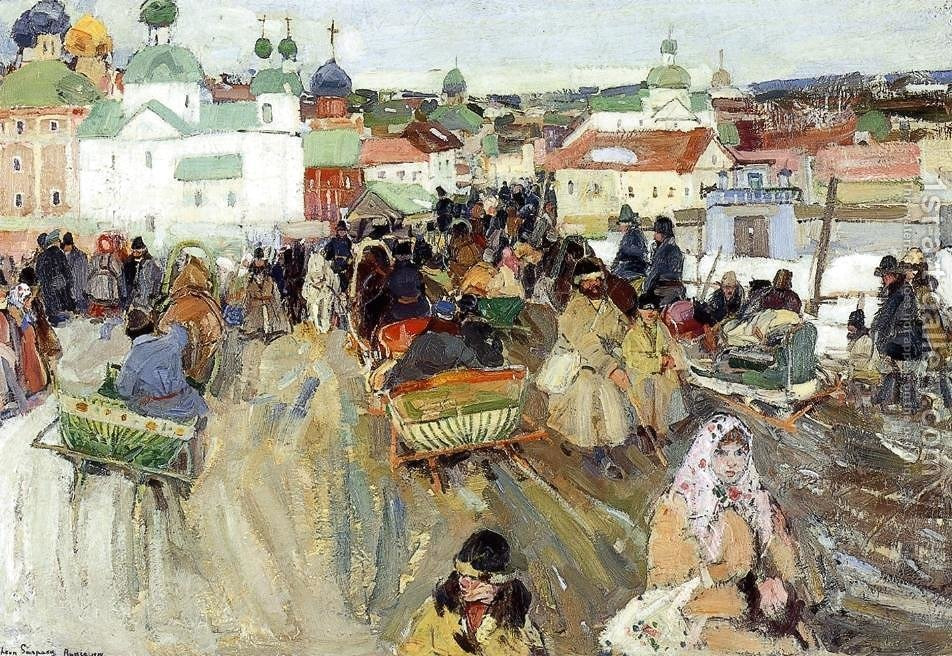
Russian Christmas
Leon Schulman Gaspard (1882-1964)
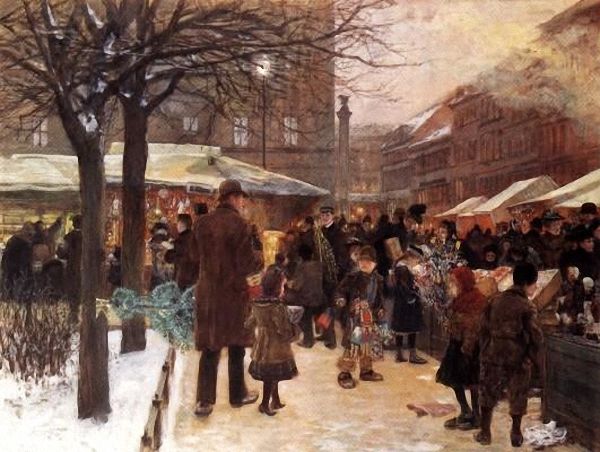
The Christmas Market in Berlin (1892)
Franz Skarbina (1849-1910)
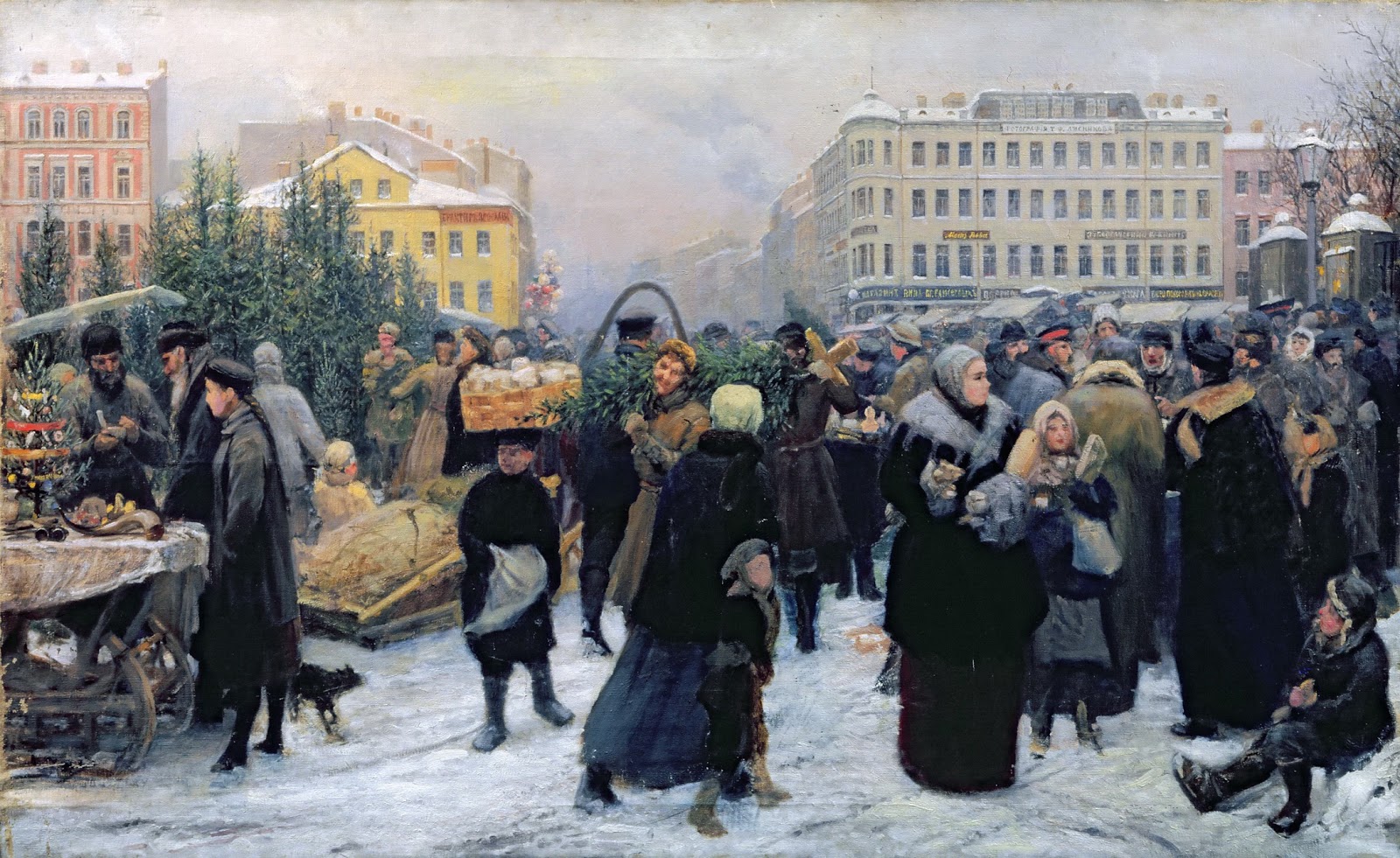
Christmas Fair (1904)
Heinrich Matvejevich Maniser
Nature-Based vs Anti-Nature
Polydore Vergil (c.1470–1555), the Italian humanist scholar,
historian, priest and diplomat, who spent most of his life in
England, wrote this about Christmas: “Dancing, masques, mummeries,
stage-plays, and other such Christmas disorders now in use with the
Christians, were derived from these Roman Saturnalian and
Bacchanalian festivals; which should cause all pious Christians
eternally to abominate them.”[5]
However, Clement Miles takes a more positive view
of these traditions. He writes: “The heathen folk festivals absorbed
by the Nativity feast were essentially life-affirming, they
expressed the mind of men who said “yes” to this life, who valued
earthly good things. On the other hand Christianity, at all events
in its intensest form, the religion of the monks, was at bottom
pessimistic as regards this earth, and valued it only as a place of
discipline for the life to come; it was essentially a religion of
renunciation that said “no” to the world.” [6]
Now we have a religion of consumerism and mass
consumption with Santa Claus as its main protagonist. The one
extreme of the sacred St Nicholas has flipped over to the other
extreme of Santa, the corporate saint. Either way the pious and the
consumer pose no threat to the status quo.
Catharsis
There is no doubt that the Christmas festivities
were used by elites as a form of social catharsis. The Lord of
Misrule and the Bean King, encouraged by raucous mummers and lively
caroling, allowed the lowly to throw off pent-up aggression and feel
what it was like to be in a position of power for a very short
period of time. This brief social revolution was an important part
of midwinter celebrations such as the Roman Kalends and the Feast of
Fools. Libanius (c.314–392 or 393), the fourth century Greek
philosopher, wrote: “The Kalends festival banishes all that is
connected with toil, and allows men to give themselves up to
undisturbed enjoyment. From the minds of young people it removes two
kinds of dread: the dread of the schoolmaster and the dread of the
stern pedagogue. The slave also it allows, so far as possible, to
breathe the air of freedom.” [7]
The survivals of an ancient time when man and nature
were at peace (see article here),
and not enslaved and forced to overexploit our natural resources for
the benefit of the few, were allowed to resurface briefly at the
time of year when the labouring classes were mostly idle and, once
sated, posed little threat. Yet, retaining the memory of past
respectful attitudes towards nature and old traditions of social
upheaval will go a long way towards healing our damaged home into
the future.
Notes:
[1] Clement A. Miles, Christmas Customs and
Traditions: Their History and Significance, Dover Publications,
2017, p47.
[2] Miles, Christmas Customs and Traditions,
p170.
[3] Miles, Christmas Customs and Traditions,
p163.
[4] James Frazer, The Golden Bough, Wordsworth, 1994. See:
The tree-spirit p297, Green George p126, Jack-in-the-Green p128, the
Little Leaf Man p128 and the Leaf King p130.
[5] Hazlitt, W. Carew, Faiths and Folklore of the British Isles,
2 vols, New York: Benjamin Blom, Inc., 1965, p118-19
[6] Miles, Christmas Customs and Traditions, p25.
[7] Miles, Christmas Customs and Traditions, p168.
Sacred Trees, Christmas Trees and New Year Trees: a
Vision for the Future
Caoimhghin Ó Croidheáin
Trees are a very important part of world culture and
have been at the centre of ideological conflict for hundreds of
years. Over this time they have taken the form of Sacred trees,
Christmas trees and New Year trees. In the current debates over
climate change, trees have an immensely important role to play on
material and symbolical levels both now and in the future. With the
rising awareness of climate change, climate resilience i.e. the
ability to recover from or adjust easily to misfortune or change,
has become the focus of groups from local community action to global
treaties. The planting of trees is an important action that everyone
from the local to the global can engage in. Trees act as carbon
stores and carbon sinks, and on a cultural level they have been used
to represent nature itself the world over.
As symbols, trees have been imbued with different
meanings over time and I suggest here that they should continue to
hold that central role as a prime symbol of our respect for nature,
and not just at Christmas time but the whole year round in the form
of a central community tree for adults and children alike. In an
uncertain future, the absolute necessity of developing a society
that harks back to much earlier forms of engagement with nature in a
sustainable way will have to have a focal point. Trees as important
symbols of our respect for nature have a long and elemental past.
The Tree of Life
From earliest times trees have had a profound effect
on the human
psyche:
“Human beings, observing the growth and death of
trees, and the annual death and revival of their foliage, have often
seen them as powerful symbols of growth, death and rebirth.
Evergreen trees, which largely stay green throughout these cycles,
are sometimes considered symbols of the eternal, immortality or
fertility. The image of the Tree of life or world tree occurs in
many mythologies.”
In Norse mythology the tree
Yggdrasil,
“with its branches reaching up into the sky, and roots deep into the
earth, can be seen to dwell in three worlds – a link between heaven,
the earth, and the underworld, uniting above and below. This great
tree acts as an Axis mundi, supporting or holding up the cosmos, and
providing a link between the heavens, earth and underworld.”
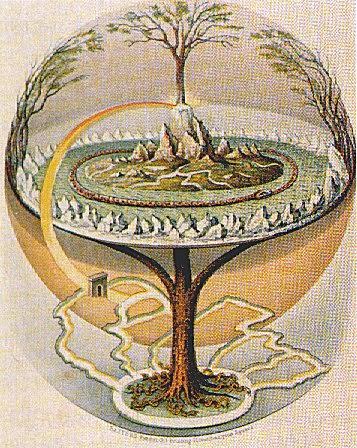
Yggdrasil, the World Ash (Norse)
Sacred Trees
However, both Christianity and Islam treated the
worship of trees as idolatry and this led to sacred trees being
destroyed in Europe and most of West Asia. An early representation
of the ideological conflict between paganism (polytheistic beliefs)
and Christianity (resulting in the cutting down of a sacred tree)
can be seen in the manuscript illumination (illustration) of Saint
Stephan
of Perm cutting down a birch tree sacred to the Komi people as part
of his proselytizing among them in the years after 1383.
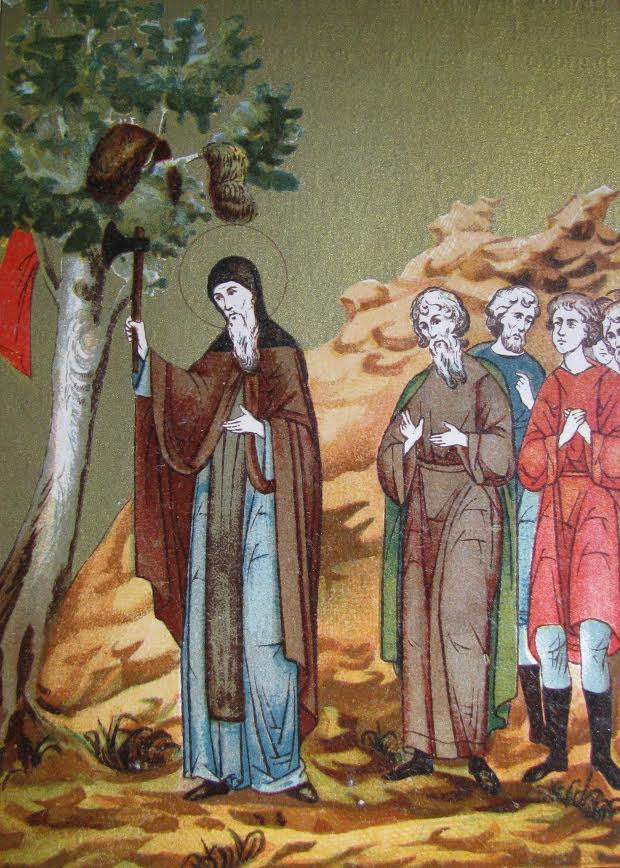
Stefan of Perm takes an axe to a birch hung with pelts
and cloths that is sacred to the Komi of Great Perm (a medieval
Komi state in what is now the Perm Krai of the Russian
Federation.)
Christian missionaries targeted sacred groves and
sacred trees during the Christianization of the Germanic peoples.
According to the 8th century Vita Bonifatii auctore Willibaldi, the
Anglo-Saxon missionary Saint Boniface and his retinue cut down
Donar’s Oak
(a sacred tree of the Germanic pagans) earlier the same century and
then used the wood to build a church.

“Bonifacius” (1905) by Emil Doepler.
Christmas Trees
Over time the
pagan world tree became christened as a Christmas tree. It was
believed that evil influences were warded off by fir or spruce
branches and “between December 25 and January 6, when evil spirits
were feared most, green branches were hung, candles lit – and all
these things were used as a means of defense. Later on, the
trees themselves were used for the same purpose; and candles
were hung on them. The church retained these old customs, and gave
them a new meaning as a symbol of Christ.’(p20) While there are
records of this practice dating from 1604 of a decorated fir tree in
Strasbourg, it was in Germany that the Christmas tree took hold in
the early 19th century. It
then
“became popular among the nobility and spread to royal courts as far
as Russia.”

Father and son with their dog collecting a tree in the
forest, painting by
Franz Krüger (1797–1857)
The Russian Revolution
In Russia the tradition of installing and decorating
a Yolka (tr: spruce tree) for Christmas was very popular but fell
into disfavor (as a tradition originating in Germany – Russia’s
enemy during World War I) and was subsequently banned by the Synod
in 1916. After the
Russian Revolution in 1917 Christmas celebrations and other
religious holidays were prohibited under the Marxist-Leninist policy
of state atheism in the Soviet Union.

A 1931 edition of the Soviet magazine Bezbozhnik,
distributed by the League of Militant Atheists, depicting an
Orthodox Christian priest being forbidden to cut down a tree for
Christmas
New Year’s trees
Although the Christmas tree was banned people
continued the tradition with
New Year
trees which eventually gained acceptance in 1935: “The New Year tree
was encouraged in the USSR after the famous letter by Pavel
Postyshev, published in Pravda on 28 December 1935, in which he
asked for trees to be installed in schools, children’s homes, Young
Pioneer Palaces, children’s clubs, children’s theaters and cinemas.”
They remain an essential part of the Russian New Year
traditions when
Grandfather Frost, like Santa Claus, brings presents for children to
put under the tree or to distribute them directly to the children on
New Year’s morning performances.
Trees in public places
In many public places around the world Christmas
trees are displayed prominently since the early 20th century. The
lighting up of the tree has become a public event signaling the
beginning of the Christmas season. This is now usual even in small
towns whereby a large fir is chopped down and displayed prominently
in a central part of the town or village. While fir trees are now
grown expressly for sale and display, in the past the cutting down
of whole trees (maien or meyen) was
forbidden: “Because of the pagan origin, and the depletion of
the forest, there were numerous regulations that forbid, or put
restrictions on, the cutting down of fir greens throughout the
Christmas season.”(p20)

Bringing Home the Tree by
Norman Rockwell. 12/18/1920.
Not cutting down trees
However if we look at the origins of sacred trees
the important point was that they were not to be cut down, as
respect for nature took precedence. The cutting down and destruction
of so many trees today has become an important part in the
commercialization of Christmas. However, growing a tree in the
centre of villages, towns and cities as the focal point of our
relationship with nature could be a year round celebration for
adults and children and another aspect of the call for climate
resilience policies the world over. The tree could then be decorated
at Christmas or New Year. The decorations can be removed from the
tree afterwards, allowing it to become a focal point for other
festivities throughout the year. The educational value of this
strategy for children would also be as an object lesson in the
importance of sustainability and conservation.
Celebrating nature by chopping down the material
reality of nature in the form of a tree every year is a
contradiction in terms and could be remedied by encouraging people
to grow trees or buying potted fir trees instead. Our ancestors from
all over the world knew the importance of the balance of nature and
tried to keep that balance through rites and prayers before the
sacred trees. Now, in an era of climate change, rapidly becoming
climate chaos, it is incumbent on us more than ever to develop a new
appreciation and respect for nature and especially for trees as a
primary symbol of that relationship.
The Origins of Violence? Slavery, Extractivism
and War
by Caoimhghin Ó Croidheáin / April 27th, 2018
And the land, hitherto a common possession like
the light of the sun and the breezes, the careful
surveyor now marked out with long-drawn boundary lines.
Not only were corn and needful foods demanded of the
rich soil, but men bored into the bowels of the earth,
and the wealth she had hidden and covered with Stygian
darkness was dug up, an incentive to evil. And now
noxious iron and gold more noxious still were produced:
and these produced war – for wars are fought with both –
and rattling weapons were hurled by bloodstained hands.
(Ovid, written around 8 AD which laments humanity’s
loss of its original Golden condition [Ovid
Metamorphoses, Book 1, The Iron Age]).
The privatisation of property, extractivism, the
necessity for food-producing slaves and a warrior class to
sustain and further extend the aims of the elites are all
neatly summed up in this quote from Ovid. What is noticeable
and notable is that over the millennia very little has
changed in substance. We still have today wage slaves,
standing armies, extractivism and industrialised agriculture
that is oriented and controlled according to the aims and
agendas of a warmongering elite. However, it seems that
things were not always thus.
The coming of the Kurgan peoples across Europe from c.
4000 to 1000 BC is believed to have been a tumultuous and
disastrous time for the peoples of Old Europe. The Old
European culture is believed to have centred around a
nature-based ideology that was gradually replaced by an
anti-nature, patriarchal, warrior society. According to the
archeologist and anthropologist, Marija Gimbutas:
Agricultural peoples’ beliefs concerning sterility
and fertility, the fragility of life and the constant
threat of destruction, and the periodic need to renew
the generative processes of nature are among the most
enduring. They live on in the present, as do very
archaic aspects of the prehistoric Goddess, in spite of
the continuous process of erosion in the historic era.
Passed on by the grandmothers and mothers of the
European family, the ancient beliefs survived the
superimposition of the Indo-European and finally the
Christian myths. The Goddess-centred religion existed
for a very long time, much longer than the Indo-European
and the Christian (which represent a relatively short
period of human history), leaving behind an indelible
imprint on the Western psyche.

The Goddess Timeline
A chronological record of archaeological images of women and
goddesses on a uniform time scale from 30,000 BCE to the
present.
Copyright © 2012
Constance Tippett
Gimbutas notes that it was at this time that a relatively
homogeneous pre-Indo-European Neolithic culture in
southeastern
Europe was “invaded and destroyed by horse-riding
pastoral nomads from the Pontic-Caspian steppe (the “Kurgan
culture”) who brought with them violence, patriarchy, and
Indo-European languages”. While this model has been disputed
over the years recent research has broadened and deepened
our understanding of these movements.
In 2015 an international team of researchers conducted a
genetic study which backs the Kurgan
hypothesis, that “a massive migration of herders from
the Yamna culture of the North Pontic steppe (Russia,
Ukraine and Moldavia) towards Europe which would have
favoured the expansion of at least a few of these
Indo-European languages throughout the continent.”
Another disputed aspect of the
hypothesis is the ‘how’- whether “the indigenous
cultures were peacefully amalgamated or violently
displaced.” However, the representations of weapons
engraved in stone, stelae, or rocks appear after the Kurgan
invasions as well as “the earliest known visual images of
Indo-European warrior gods”.
The beginning of slavery is also seen to be linked to these
armed invasions.
According to Riane Eisler, archeological evidence
“indicate that in some Kurgan camps the bulk of the female
population was not Kurgan, but rather of the Neolithic Old
European population. What this suggests is that the Kurgans
massacred most of the local men and children but spared some
of the women who they took for themselves as concubines,
wives, or slaves.”
Gimbutas believed that the pre-Kurgan society of Old Europe
was a “gylanic [sexes were equal], peaceful, sedentary
culture with highly developed agriculture and with great
archtectural, sculptural, and ceramic traditions” which was
then replaced by patriarchy; patrilineality; small scale
agriculture and animal husbandry”, the domestication of the
horse and the importance of armaments (bow and arrow, spear
and dagger).
Not so th’ Golden Age, who fed on fruit,
Nor durst with bloody meals their mouths pollute.
Then birds in airy space might safely move,
And tim’rous hares on heaths securely rove:
Nor needed fish the guileful hooks to fear,
For all was peaceful; and that peace sincere.
Whoever was the wretch, (and curs’d be he
That envy’d first our food’s simplicity!)
Th’ essay of bloody feasts on brutes began,
And after forg’d the sword to murder man.
— Ovid Metamorphoses
Book 14
The idea of a fall, the end of a Golden Age is a common
theme in many ancient cultures around the world. Richard
Heinberg, in Memories and Visions of Paradise,
examines various myths from around the world and finds
common themes such as sacred trees, rivers and mountains,
wise peoples who were moral and unselfish, and in harmony
with nature and described heavenly and earthly paradises.
In another book, The Fall: The Insanity of the Ego in
Human History and the Dawning of a New Era, Steve Taylor
takes a psychological approach to the concept of the Fall
examining what he calls the new human psyche and the Ego
Explosion (which created a lack of empathy between human
beings) and resulted in our alienation from nature while
making us both self and globally destructive.
However, James DeMeo takes a more radical approach in his
book, Saharasia: The 4000 BCE Origins of Child Abuse,
Sex-Repression, Warfare and Social Violence in the Deserts
of the Old World. He believes that climatic changes
caused drought, desertification and famine in North Africa,
the Near East, and Central Asia (collectively Saharasia) and
this trauma caused the development of patriarchal,
authoritarian and violent characteristics.

God creates Man
“Then the LORD God formed a man from the dust of the ground
and breathed into his nostrils the breath of life, and the
man became a living being.”(Gen
2:7)
Author unknown, Creation of Adam, Byzantine mosaic in
Monreale, 12th century.
The arrival of violent, enslaving tribes and of a supreme
male deity led to the eventual demise of the female deities
through demotion or destruction of temples and statues.
Over time, the many traditions of pre-patriarchal nature
worship were destroyed (such as cutting down sacred trees)
or eventually assimilated into the new patriarchal religions
(see my
Christmas article). Thus many of the nature-based ideas
of matriarchal religion were turned on their head as the
male deity creates man and Adam gives birth to Eve.
According to Barbara Walker, in The Women’s Encyclopedia
of Myths and Secrets, “usurpation of the feminine power
of birth-giving seems to have been the distinguishing mark
of the earliest gods.” She lists the many ways the male
deities ‘gave birth’; e.g., from the mouth (Prajapati), from
the head or thigh (Zeus), from the penis (Atum), or from the
stomach (Kun) in the section ‘Birth-Giving, Male’.

Adam ‘gives birth’ to Eve
“For man did not come from woman, but woman from man”(1
Corinthians 11:8)
From: Master
Bertram, Grabow Altarpiece, 1379-1383
In Christianity the rulers had a religion that assured
their objectives. The warring adventurism of the new rulers
needed soldiers for their campaigns and slaves to produce
their food and mine their metals for their armaments and
wealth. Thus, Christ was portrayed as Martyr and Master. In
his own crucifixion as Martyr he provided a brave example to
the soldiers and as Master he would reward or punish the
slaves according to how well they had behaved.

Christ as Martyr and Master
Jan van Eyck (before c. 1390 – 9 July 1441)
Crucifixion and Last Judgement diptych, c. 1430–1440.
Metropolitan Museum of Art, New York
Christianity, according to Helen Ellerbe:
has distanced humanity from nature. As people came
to perceive God as a singular supremacy detached from
the physical world, they lost their reverence for
nature. In Christian eyes, the physical world became the
realm of the devil. A society that had once celebrated
nature through seasonal festivals began to commemorate
biblical events bearing no connection to the earth.
Holidays lost much of their celebratory spirit and took
on a tone of penance and sorrow. Time, once thought to
be cyclical like the seasons, was now perceived to be
linear. In their rejection of the cyclical nature of
life, orthodox Christians came to focus more upon death
than upon life.
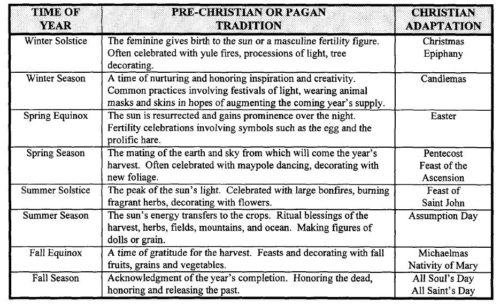
Pagan festivals chart: [From The Dark Side of Christian
History, Helen Ellerbe]
"Then God said, “Let us make humankind in our image,
according to our likeness; and let them have dominion over
the fish of the sea, and over the birds of the air, and over
the cattle, and over all the wild animals of the earth, and
over every creeping thing that creeps upon the earth.”
So God created humankind in his image,
in the image of God he created them;
male and female he created them.
God blessed them, and God said to them, “Be fruitful and
multiply, and fill the earth and subdue it; and have
dominion over the fish of the sea and over the birds of the
air and over every living thing that moves upon the earth.”
"
(Genesis 1:26-28)
According to Fred Magdoff and Chris Williams:
"A rigidly anthropocentric view stemming from biblical
conceptions of the domination of nature and placement of
earth at the service of humans holds that humans are not
only the center and most important part of life on Earth but
sit at the apex of biological development. It is therefore
our right to dominate and exploit the rest of nature. This
view is a complete misunderstanding of the science of
evolution and ecology. However distantly, all living
organisms are connected to one another through evolution. We
are one of an estimated 8.7 million species living on Earth.
Even among mammals, Homo sapiens is only one of more than
5,000 species."
Creating an Ecological Society: Toward a Revolutionary
Transformation by Fred Magdoff and Chris Williams (2017)
p.158
Christian eschatology (study concerned with the ultimate
destiny of the individual soul and the entire created order)
and the idea of linear time took over from the people’s
strong connection with nature and the ever-changing seasons.
Although, in early medieval times, according to David Ewing
Duncan in The Calendar, the peasants still lived and
died “in a continuous cycle of days and years that to them
had no discernible past or future.”
Different seasonal festivals such as the solstice, the
Nativity, Saturnalia, Yuletide, the Easter hare and Easter
eggs etc. all had pre-Christian connections but old habits
died hard and left the church no choice but to incorporate
some aspects of them into their own traditions over time.
Feminism vs class
While some aspects of the culture of prehistory are still
with us today, interpretation of the artifacts from
archeological digs has always been open to controversy. For
example, Cynthia Eller in her book The Myth of
Matriarchal Prehistory: Why An Invented Past Will Not Give
Women a
Future believes that the theory of a prehistoric
matriarchy (female rulership) was “developed in 19th
century scholarship and was taken up by 1970s second-wave
feminism following Marija Gimbutas.” However, the feminist
historian Max Dashu
notes that Eller “makes no distinction between scholarly
studies in a wide range of fields and expressions of the
burgeoning Goddess movement, including novels, guided tours,
market-driven enterprises. All are conflated all into one
monolithic ‘myth’ devoid of any historical foundation.”
The important point here is that ideas of matriarchal
prehistory have been used in feminist theory to blame men
for war and violence today (ignoring Thatcher and May).
Sure, men have been dominant in the warring elites but many,
many more men were caught up in the enslaved soldiers,
miners and farmers classes. And as it was violence that was
used to enslave them in the first place historically, then
surely it would be no surprise if violence is used by them
in the fight back against their slavery (class struggle).
The reappraisal of our ancient past and our relationship
with nature has become an urgent necessity as climate chaos
occupies more and more of our time and energy. It is not too
late to learn from the myths of the Golden Age and Ovid’s
ancient complaints to create a better future.
This let me further add, that Nature knows
No steadfast station, but, or ebbs, or flows:
Ever in motion; she destroys her old,
And casts new figures in another mould.
— Ovid, Metamorphoses
Book 15
Notes:
Caoimhghin Ó Croidheáin is an Irish artist,
lecturer and writer. His
artwork
consists of paintings based on contemporary geopolitical
themes as well as Irish history and cityscapes of
Dublin. His blog of critical writing based on cinema,
art and politics along with research on a database of
Realist and Social Realist art from around the world can
be viewed country by country at
http://gaelart.blogspot.ie/.
Read other articles by Caoimhghin.
This article was posted on
Friday, April 27th, 2018
Sex, Drugs and Rollickin’ Roles:
Christmas and Our Ever-Changing Relationship with Nature
by Caoimhghin Ó Croidheáin / December
20th, 2017
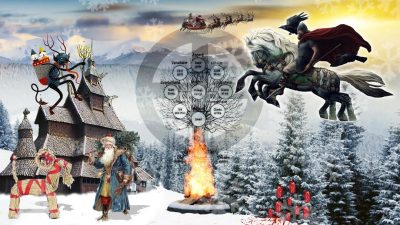
Traditions of the
Winter Solstice
Christmas is an ancient feast that has many positive
associations for people around the world. While the bible places the
birth of Christ in Bethlehem it does not say when, but by the 4th
century the Churches in the East were celebrating it on January 6
and the Churches of the West on December 25.
One thing is certain about Christmas is that it is
rooted in many traditions and superstitions relating to nature that
existed long before Christmas and many have continued in one form or
another to the present day. The many strands of Christmas can be
seen in the variety of different traditions associated with, or
originating in, places all over Europe. These strands are, inter
alia, the solstice, the Nativity, Saturnalia, Yuletide, St
Nicholas, Father Christmas, and Grandfather Frost (Ded Moroz).
The association of Christmas with its earlier
midwinter nature worship traditions declined as the Church exerted
its power and authority over pagan practices and in more recent
centuries as the industrial revolution took people away from the
land and into the cities and factories. Since then industrialisation
has taken over many aspects of people’s lives as they shifted from
being producers to consumers.
As direct contact with nature declined and
scientific knowledge was applied to production, our lives were made
easier by an abundance of relatively cheap goods and food. These
benefits have come at another price though as industrialisation and
technology the world over pushes nature further and further into
ecological crises. There is much discussion and debate about the
potential for a tipping point as the destruction of ecosystems and
climate change move headlong towards irreversible damage of the
Earth’s biosphere.
This has come about, partly due to our alienation
from nature, but also due to a system which blinds us to the
excesses of production through mass media, and Christmas has become
the vehicle for the worst excesses of industrialisation,
commercialisation and commodification. However, this is a gross
distortion of its roots in respecting nature and nature worship
which was ultimately about a heightened awareness of survival in an
unpredictable world.
Sex
The predominant figure of Christmas has become Santa
Claus (Dutch: Sinter Klaas) and originated in the stories around St
Nicholas, the 4th century Bishop of Myra (Turkey), giving anonymous
gifts to help people in need or trouble.
In many European regions St Nicholas came door to door with a
bishop’s mitre and crosier on his feast day, December 6. He was
accompanied by his helper Ruprecht or Krampus as he is known in the
Alpine regions. Krampus is depicted as half goat and half demon and
punished misbehaving children with a rod.

Krampus
It is believed that Krampus derives from the much
earlier pre-Christian Norse mythology and that he was the son of the
god of the underworld Hel. While the name Krampus is believed to
originate from Krampen meaning ‘claw’, Ruprecht is believed to be
from “Hruodperaht” meaning “gloriously shining one” another name of
Wotan. Their negative status is likely the result of Christian
attempts to assert dominance over the pagan peoples of the time, in
the same way that the Celtic goddess Bridget was demoted by the
Christian church to St Bridget. Krampus is an evil fertility demon
who scares children (reversing his earlier role as fertility god)
with his hazel wood rod:
The hazelnut was holy to Donar, the God of
marital and animal fertility. The hazel wood rod was considered
a great rod of life. With this symbol of the penis, women and
animals were beaten “with gusto” in order for them to become
fertile.
This fertility rite has continued to the present day
on Easter Mondays in the Czech Republic when young women are whipped
with a braided rod of willow called a
pomlázka to “assure womankind with good health, fresh look and
keep fertility. The girls then give coloured or painted eggs to boys
and men as a sign of their thanks and forgiveness.”

Pomlázka
During the 12th century the church
tried to end the Krampus celebrations but it seems that, like with
many popular traditions, they re-surfaced and were re-integrated
back into church traditions. Unlike the ‘demonised’ Krampus, the
Christian St Nicholas distributed typical gifts of nuts, dried
fruits, chocolate, spices and toys.
These gifts were also symbols of fertility. Hazelnuts helped people
survive winter as they could be easily stored and were rich in fats
and vitamins. Apples were associated with the Tree of Paradise and
dried fruits such as oranges and lemons served as fertility symbols
in the Mediterranean countries as they were the first fruit of the
year and thus herald a good harvest.
Drugs
Another major association of Norse mythology with
Christmas is the reindeer pulling the Santa’s sleigh. The first
mention of St Nicholas in the air in popular mythology is of him
“riding jollily among the tree-tops, or over the roofs of the
houses, now and then drawing forth magnificent presents from his
breeches pockets and dropping them down the chimneys of his
favourites” is by Washington Irving in his satirical work, A
History of New-York from the Beginning of the World to the End of
the Dutch Dynasty, by Diedrich Knickerbocker (1809). At
this point St Nicholas was not associated with Christmas and
presents were exchanged on the night before his feast day on
December 6.
However, in a poem written in 1822, Clement Moore
has St Nicholas arrive with his presents on the night before
Christmas and in “a miniature sleigh, and eight tiny reindeer” who
“would mount to the sky […] with a sleigh full of toys” and then go
down the chimneys to deliver his gifts thus shifting celebrations of
St Nicholas in the United States from his feast day on December 6 to
Christmas Eve on
December 24 instead.
The phenomenon of flying animals has long been
associated in Norse mythology with Wotan (Odin) and his flying eight
legged horse Sleipnir, and with Thor and his flying goat-drawn
chariot.

”Odin and Sleipnir” (1911) by
John Bauer
Wotan is depicted as one-eyed and long-bearded in
Old Norse texts and is a fierce god associated with wisdom, healing
and war. Children would leave straw in their boots for Sleipnir by
the hearth and Wotan would exchange it for a gift in return for
their
kindness.
Thor was also depicted as a fierce god of thunder
and lightning, storms, oak trees and fertility. Another god, Morozko,
the powerful and cruel Slavic god of frost and ice could freeze
people and landscapes at will, became known as
Ded Moroz (Grandfather Frost) but was eventually demonised by
the Russian Orthodox Church. As our fear of nature declined and
Christmas became more of a child-centered celebration, the
depictions of these gods became less fierce over time.
‘
Thor and Tyr
in their Goat-Drawn Chariot (From “The Book of Myths” by Amy Cruse,
1925)
The flying aspect of Santa’s reindeers is believed
to refer to the reindeers’ fondness for Fly Agaric mushrooms
associated with Old Nordic Shamanism. The Shamanic ‘flight of the
soul’ was part of the culture of people in arctic Europe and Siberia
who would communicate with the souls of their ancestors in an
altered state of consciousness helped along by the hallucinogenic
mushrooms.
Like the Church attempts to eradicate the earlier fertility
traditions and the gods associated with them, shamanism has been
considered mere superstition and attacked by both Churches and
governments alike.
It seems that what shamanism and fertility rites
have in common is the idea of directly engaging with nature to
secure desired material or spiritual goals. Both Krampus and
Shamanism have been associated with
Satan who “uses deception and demonic spirits seeking our
destruction” yet their popularity has ebbed and flowed over the
centuries without disappearing altogether.
Rollickin’ Roles
Similarly the Bacchanalian aspect of Christmas celebrations is a
survival of Saturnalia, the Roman celebration of
Saturn the “god of generation, dissolution, plenty, wealth,
agriculture, periodic renewal and liberation” which could also be
described as an engagement with the cycles of nature.
Saturnalia was “a time of feasting, role reversals, free speech,
gift-giving and revelry” held on
December 17 of the Julian calendar
and was subsequently extended to 23 December. Saturnalia originated
as a farmer’s festival to mark the end of the autumn planting season
in honour of Saturn (satus means sowing).
According to Justinus, the 2nd century Roman historian, these
celebratory aspects of Saturnalia derived from, and were explained
by, its origins with pre-Roman peoples of Italy
who:
were the Aborigines, whose king, Saturnus, is said to have been
a man of such extraordinary justice, that no one was a slave in
his reign, or had any private property, but all things were
common to all, and undivided, as one estate for the use of every
one; in memory of which way of life, it has been ordered that at
the Saturnalia slaves should everywhere sit down with their
masters at the entertainments, the rank of all being made equal.
Once again the association with nature and the Golden Age (when
people lived in peace and harmony) forms the basis of a celebration
which was to be co-opted by the Church and eventually attacked for
its excesses. According to a
Puritan minister in 17th century England, Increase Mather,
Christmas occurred on December 25 not because “Christ was born in
that month, but because the heathens’ Saturnalia was at that time
kept in Rome, and they were willing to have those pagan holidays
metamorphosed into Christian [ones]. Stephen Nissenbaum, in his book
The Battle for Christmas,
writes:
Puritans believed Christmas was basically just a pagan custom
that the Catholics took over without any biblical basis for it.
The holiday had everything to do with the time of year, the
solstice and Saturnalia and nothing to do with Christianity.
Presumably the masters could not cope with the concept of equality
and saw Saturnalia instead as a role reversal. In pre-industrial
England people would elect a Lord of Misrule who would be in charge
of Christmas festivities and who even had license to poke fun at the
nobility.
Yet the Lords of Misrule were an important aspect of Christmas as
the reversal of traditional social norms was a safety valve for
class tensions in England. It was around this time that the
personification of Christmas as Father Christmas began to appear.

Father
Christmas 1848
He was associated not with children, presents,
chimneys or stockings, but with adult merrymaking and feasting.
During Christmas ‘great quantities of brawn, roast beef,
‘plum-pottage’, minced pies and special Christmas ale were consumed’
and people enjoyed singing, dancing and card games resulting in
‘drunkenness, promiscuity and other forms of excess.’ Thus when the
Puritans took over government in the 1640s they tried ‘to
abolish the Christian festival of Christmas and to outlaw the
customs associated with it’. The satirical Royalist poet, John
Taylor, wrote in The Complaint of Christmas:
All the liberty and harmless sports, with the merry gambols,
dances and friscals [by] which the toiling plowswain and
labourer were wont to be recreated and their spirits and hopes
revived for a whole twelve month are now extinct and put out of
use in such a fashion as if they never had been. Thus are the
merry lords of misrule suppressed by the mad lords of bad rule
at Westminster.
However by the 1650s it was reported that the taverns were full on
Christmas day, churches were decorated in rosemary as usual,
Christmas Boxes had been given out, presents exchanged and mummers
paid despite the bans. Worse still violence broke out in London
when:
a large crowd of Londoners gathered to prevent the mayor and his
marshalls removing the Christmas decorations which some of the
city porters had draped around the conduit in Cornhill. The
confrontation ended in uproar, with arrests, injuries, and the
bolting of the mayor’s frightened horse.
The Christmas celebrations returned with Charles II in 1660 and
showed once again the attempt to impose a narrow religious view on
the multifaceted ancient traditions of people had failed.
Trees
Somewhat earlier, in the 14th and 15th centuries in Germany,
craftsmen began to decorate their guild halls with trees and
adorning them with fruits and nuts. This eventually led to the
German, Charlotte, who married King George III in 1761, potting up
and decorating a yew tree and initiating the custom in England.
Legend has it that in Germany, St Boniface, an historical figure
from the 7th century, saw a group of people honouring the sacred
tree, Donar’s Oak (sometimes referred to as Thor’s Oak) somewhere
around Hesse, became angry and chopped the tree down (and added
insult to injury by using the wood to build his church).

St Boniface chopping the oak tree
Sacred trees and sacred groves were very important to the Germanic
peoples and were too important to be cut down. Again we can see that
the earlier traditions of pre-Christian society revolved around
revering
nature:
Some were wont secretly, some openly to sacrifice to trees and
springs; some in secret, others openly practiced inspections of
victims and divinations, legerdemain and incantations; some
turned their attention to auguries and auspices and various
sacrificial rites; while others, with sounder minds, abandoned
all the profanations of heathenism, and committed none of these
things.
Over time, cutting the evergreen tree and bringing it indoors became
an important part of Christmas traditions [see my previous article
on
Christmas trees] despite church proscription, because of its
shamanic-pagan past.
Another early nature-based tradition is the wassail
in England.
Wassailing is a very ancient custom that is referenced in
history as early as the eighth-century poem Beowulf. The word
‘wassail’ is believed to be derived from the Old Norse ‘ves heil’
and the Old English ‘was hál’ and meaning “be in good health” or “be
fortunate.” The wassail had an important significance for
farmers:
In parts of Medieval Britain, a different sort of wassailing
emerged: farmers wassailed their crops and animals to encourage
fertility. An observer recorded, “They go into the Ox-house to
the oxen with the Wassell-bowle and drink to their health.” The
practice continued into the eighteenth century, when farmers in
the west of Britain toasted the good health of apple trees to
promote an abundant crop the next year. Some placed cider-soaked
bread in the branches to ward off evil spirits. In other
locales, villagers splashed the trees with cider while firing
guns or beating pots and pans.

Wassailing the Apple Tree
The
Apple Tree Wassail lyrics anticipate the next year and a good
crop:
(It’s) Our wassail jolly wassail!
Joy come to our jolly wassail!
How well they may bloom, how well they may bear
So we may have apples and cider next year.
Solstice and the Unconquered Sun
Our awareness of mid winter and the solstice (‘sun
stands still’) is shown to go back to the late Neolithic and Bronze
Age with Newgrange in Ireland and Stonehenge in England. In both
cases the monuments have been aligned to the solstice, sunrise at
Newgrange and sunset at Stonehenge. It has been the occasion of
celebrations, rituals and gatherings as the sun appears to be reborn
and the days start getting longer again. After this time food became
scarce (January to April) which were known as the ‘famine months’.
It was the last feast of the year as cattle were slaughtered and
wine and beer were ready for drinking. The ‘rebirth’ of the sun was
known as Sol Invictus or the ‘unconquered sun’ god during the Roman
Empire in the 3rd century CE and the Emperor Aurelian dedicated a
temple to Sol to be celebrated on
December 25. Solar deities have been
represented as both gods and goddesses in different cultures and are
particularly important in mid winter when the sun is low in the sky.
In many countries in Europe the tradition of the Yule log burning
was an important festival to help strengthen the weakened sun.

Yule log
A
large log, big enough to burn for the 12 days of Christmas, was
brought into the houses and burned. It was believed to have
originated with the Norse and the Celts who had large bonfires to
welcome the return of the sun. The log was thought to have magical
properties and the ashes were then used as fertiliser and as cures
for both people and animals and would protect them for the year to
come.
Nature
Throughout the world there have been many forms of
nature worship demonstrating that people respected and feared nature
in equal amounts over the millennia. We have a complex relationship
with nature, indeed we are an important part of nature. We have to
negotiate every aspect of that relationship, be it food, water,
reproduction, climate (storms avalanches, floods, droughts, fires),
the seasons, the geophysical (earthquakes, tsunamis, volcanoes),
light (length of day, sleeping during hours of darkness) etc.
In the past people hoped and prayed that in the next
year nature would allow them to live well again and consequently
treated nature with respect. To do that people were careful not to
over-exploit nature in various ways: by leaving land fallow, having
food taboos, allowing areas to regenerate by moving on, by not
over-using a food resource, thus creating the basis of
sustainability into the future. Their respectful attitude to nature
was reflected in what we call superstitions and paganism but it
allowed them to celebrate Christmas without guilt in the knowledge
that they had treated nature well and that nature would reciprocate
with a bountiful harvest the next year.
Today, on the other hand, we are alienated from this
way of thinking and living to the extent that people have lost
direct control of their relationship with nature. The ever
increasing industrial overproduction of meat, over-fishing,
over-fertilisation, deforestation, air pollution and extractivism is
pushing nature to extremes and already we are seeing the
catastrophic results of this in climate change. Maybe as climate
change brings ever fiercer storms and destruction of food production
we will learn to respect and fear nature again.
https://dissidentvoice.org/2017/12/sex-drugs-and-rollickin-roles-christmas-and-our-ever-changing-relationship-with-nature/
Notes:
|




































